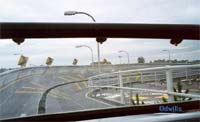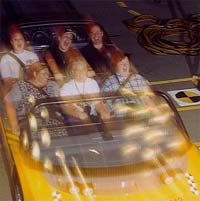is there a way i could take a test to study for the real one
Want to feel like a dummy? Try out Test Track
By: Drivers.com staff
Date: Wednesday, 14. March 2007
Auto buffs planning to take the family to Florida's Disney World this winter should definitely put the Epcot Center's Test Track thrill ride on their "things to do" list.
 Test
Track is a spectacular re-creation of GM's Milford Proving Ground northwest
of Detroit. It includes a high-speed barrier crash test simulation as part
of its behind-the-scenes look at how the car company incorporates safety into
the development of every vehicle long before they reach the showroom.
Test
Track is a spectacular re-creation of GM's Milford Proving Ground northwest
of Detroit. It includes a high-speed barrier crash test simulation as part
of its behind-the-scenes look at how the car company incorporates safety into
the development of every vehicle long before they reach the showroom.
"It's rare that consumers get a behind-the-scenes look at how much effort we put into the development and testing of our vehicles," says Phil Guarascio, GM vice president, advertising and corporate marketing. "In addition to delivering a thrilling experience, Test Track is a compelling illustration of GM's commitment to safety, quality and advanced technology."
The exhilarating experience that riders on Test Track experience during the brief-but intense-ride represents only a fraction of the testing GM carries out each day at Milford Proving Ground, which was founded in 1924 to give engineers and designers detailed information on vehicle performance.
The facility began modestly as a 1,125-acre site with two buildings and five-and-a-half miles of test roads (four of which were gravel). Over time, Milford has grown to a 4,000-acre complex with 128 miles of test roads of every conceivable material, and 106 buildings and laboratories totaling nearly 2 million square feet. More than 4,700 employees maintain the around-the-clock operation.
 In
1994, the Milford Proving Ground achieved two significant milestones: the one
billionth test mile driven and the 10,000 th safety crash test conducted. But
crash testing is only one of hundreds of different evaluations conducted on
vehicles there. These include validation tests for new parts, components, and
safety systems, as well as tests for electromagnetic compatibility, emissions,
noise and vibration, brakes, and other factors that affect vehicle development.
In
1994, the Milford Proving Ground achieved two significant milestones: the one
billionth test mile driven and the 10,000 th safety crash test conducted. But
crash testing is only one of hundreds of different evaluations conducted on
vehicles there. These include validation tests for new parts, components, and
safety systems, as well as tests for electromagnetic compatibility, emissions,
noise and vibration, brakes, and other factors that affect vehicle development.
The vehicles that transport riders through Test Track were inspired by a HYGE sled that simulates actual vehicles in controlled crash tests. "HYGE," which stands for hydraulic-controlled gas-energized, is a test sled that allows engineers at Milford to dramatically simplify the testing process while still obtaining the necessary data. Visitors to Epcot's Test Track are in command of their test vehicles, but at times the ride may make them feel like the dummies used to collect data during crash tests.
GM makes extensive use of anthropomorphic test devices (ATDs)-better known as crash test dummies-to precisely measure the impact of more than 500 intentional crashes conducted each year at Milford and other test centers around the world.
These ATDs cost nearly $100,000, come in all weights and sizes, and are wired with sophisticated electronic sensors. During a crash simulation lasting a mere two-fifths of a second, the sensors transmit a continuous stream of data from dozens of measurements to a computer.
A useful version of the ATD is SID, or "side-impact dummy", that collects data during side-impact testing. Working with the Society of Automotive Engineers, GM researchers are currently perfecting the Biofidelic Side Impact Dummy, or BioSID, whose highly realistic mimicry of the human response to crash forces may become the basis for new federal standard for ATDs.
The testing at Milford includes crash tests into moving and stationary barriers, and even simulates a vehicle hitting a deer-a test used to help engineers design airbag systems that will not prematurely or unnecessarily deploy.
The 31 ride vehicles at Disney World are themselves a masterpiece of engineering. Each vehicle generates 250 horsepower, roughly equal to the supercharged 3.8 liter engine in a Pontiac Grand Prix. The vehicles go from 0-65 miles an hour in 8.8 seconds. Although the ride is only five minutes long, each vehicle will travel 50,000 miles a year-about four times as much as the average U.S. car.
At the heart of this unique vehicle are three on-board computers with more processing power than a NASA space shuttle. Each Test Track vehicle has 22 tires although only four are visible. There are six braking systems on each vehicle and the entire chassis is made of composite materials.
The photos above are courtesy of www.wdwig.com. At this site you can see more photos and read personal accounts of the ride experience.
Further comments to this article have been disabled.
All Comments (3)
Showing 1 - 3 comments
![]() akeem,
akeem,
![]() Pierro Hirsch,
Pierro Hirsch,
Regarding drivers tests on driving simulators (computer-generated driving scenes that interact with real drivers), my company Virage Simulation, viragesimulation com, is developing such a test. If Patricia is interested in being a trial student, feel free to contact us.
Best regards,
Pierro
![]() Patricia,
Patricia,
Is there a wya where i could take a drivers test on the computer for my permit. thank you
